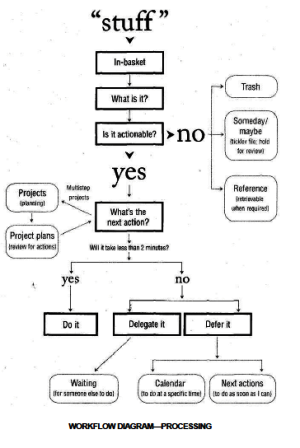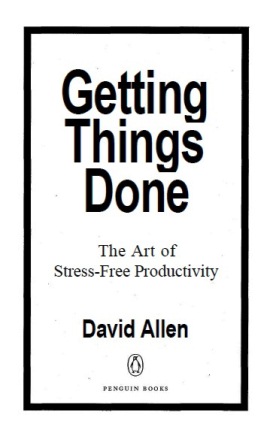'Getting things done. The Art of Stress-Free productivity' (Reseña del libro de David Allen)
Sus ideas principales son:
1) Hay que vaciar la mente de cosas pendientes, y ponerlo en un sistema externo. Al quedar la mente vacía, el cerebro gana foco.
2) El sistema organizativo debe seguir una serie de pasos claros y debe ser revisado consistentemente. En su experiencia, hay una serie de malas costumbres adquiridas que los seres humanos podemos desterrar y que, una vez sustituidas, dispararán nuestra productividad.
3) El sistema de Allen combina como pocos el corto plazo y el largo plazo.
Al ser un libro quizás demasiado extenso y con una parte amplia de auto-venta, recomendamos leer el resumen del libro y, en caso necesario, acudir al original. El contenido es, en cualquier caso, muy recomendable.
Reseña
Work hard and enjoy life- This doesn't have to be an either-or proposition. It is possible to be effectively doing while you are delightfully being.
There are things we can do to facilitate personal organization and productivity. I've uncovered simple processes that we can all learn to use that will vastly improve our ability to deal proactively and constructively. The result is a guide to maximizing output and minimizing input, and to doing so in a world in which work is increasingly voluminous and ambiguous.
It is possible for a person to have an overwhelming number of things to do and still function productively with a clear head and a positive sense of relaxed control.
It requires a paradigm shift: most people will have some major work habits that must be modified before they can implement this system. This can be a significant shift in how you approach some key aspects of your day-to-day work.
Two key objectives:
1. Capturing all the things that need to get done—now, later, someday, big, little, or in between—into a logical and trusted system outside of your head and off your mind;
2. Disciplining yourself to make front-end decisions about all of the "inputs".
A paradox has emerged in this new millennium: people have enhanced quality of life, but at the same time they are adding to their stress levels by taking on more than they have resources to handle. It's as though their eyes were bigger than their stomachs.
In the old days, work was self-evident. Fields were to be plowed, machines tooled, boxes packed, cows milked, widgets cranked. You knew what work had to be done—you could see it. It was clear when the work was finished, or not finished. Now it is not:
a) We do not work alone
b) Perfection not possible
c) We live in constant change: The organizations we're involved with seem to be in constant morph mode and the average professional is more of a free agent these days than ever before.
The Old Models and Habits Are Insufficient. "ABC" priority codes and daily "to-do" lists were key techniques that people developed to help them sort through their choices in some meaningful way. They are partially useful today.
Methodology of Getting things done helps to pick up the mind like water state.
The Principle: Dealing Effectively with Internal Commitments. You've probably made many more agreements with yourself than you realize, and every single one of them-big or little—is being tracked by a less-than-conscious part of you. These are the "incompletes," or "open loops," which I define as anything pulling at your attention that doesn't belong where it is.
The Value of a Bottom-Up Approach. Start with the most mundane, ground-floor level of current activity and commitments. Intellectually, it is counter-intuitive.
Many executives I have worked with during the day to clear the decks of their mundane "stuff" have spent the following evening having a stream of ideas and visions about their company and their future. This happens as an automatic consequence of unsticking their workflow.
The 5 stages of mastering workflow
The 5 stages of mastering workflow are:
(1) collect things that command our attention;
(2) process what they mean and what to do about them; and
(3) organize the results, which we
(4) review as options for what we choose to
(5) do.

Get It All Out of Your Head. Teaching them the item-by-item thinking required to get their collection buckets empty is perhaps the most critical improvement I have made for virtually all the people I've worked with.
There are seven primary types of things that you'll want to keep track of and manage from an organizational perspective:
• A "Projects" list
• Project support material
• Calendared actions and information
• "Next Actions" lists
• A "Waiting For" list
• Reference material
• A "Someday/Maybe" list
Projects. I define a project as any desired result that requires more than one action step. Projects do not need to be listed in any particular order, whether by size or by priority. They just need to be on a master list so you can review them regularly enough to ensure that appropriate next actions have been defined for each of them.
Any less-than-two-minute actions that you perform, and all other actions that have already been completed, do not, of course, need to be tracked; they're done. What does need to be tracked is every action that has to happen at a specific time or on a specific day (enter these in your calendar); those that need to be done as soon as they can (add these to your "Next Actions" lists); and all those that you are waiting for others to do (put these on a "Waiting For" list).
Three things go on your calendar:
• time-specific actions;
• day-specific actions; and
• day-specific information: The calendar is also the place to keep track of things you want to know about on specific days—not necessarily actions you'll have to take but rather information that may be useful on a certain date.
No More "Daily To-Do" Lists on the calendar. Those three things are what go on the calendar, and nothing else! I know this is heresy to traditional time-management training, which has almost universally taught that the "daily to-do list" is key. But such lists don't work, for two reasons:
• First, constant new input and shifting tactical priorities reconfigure daily work. Trying to keep a list in writing on the calendar, which must then be rewritten on another day if items don't get done, is demoralizing and a waste of time. The "Next Actions" lists I advocate will hold all of those action reminders, even the most time-sensitive ones. And they won't have to be rewritten daily.
• Second, if there's something on a daily to-do list that doesn't absolutely have to get done that day, it will dilute the emphasis on the things that truly do.
The calendar should be sacred territory.
So where do all your action reminders go? On "Next Actions" lists, which, along with the calendar, are at the heart of daily action-management organization.
For most of us, however, the number is more likely to be fifty to 150. In that case it makes sense to subdivide your "Next Actions" list into categories (for instance, "calls" you need to make).
There are two kinds of "incubate" systems that could work for this kind of thing: "Someday/Maybe" lists and a "tickler" file.
"Someday/Maybe". It can be useful and inspiring to maintain an ongoing list of things you might want to do at some point but not now. This is the "parking lot" for projects that would be impossible to move on at present but that you don't want to forget about entirely. You'd like to be reminded of the possibility at regular intervals.
"Tickler" File. The most elegant version of holding for review is the "tickler" file, sometimes also referred to as a "suspended" or "follow-on" file. This is a system that allows you to almost literally mail something to yourself, for receipt on some designated day in the future.
Reference systems generally take two forms:
(1) topic- and area-specific storage, and
(2) general reference files.
Review
This is where you take a look at all your outstanding projects and open loops, at what I call the 10,000-foot level, on a weekly basis.
What to Review When. "Projects" list, a calendar, "Next Actions" lists, and a "Waiting For" list, not much will be required to maintain that system.
The Weekly Review is the time to:
• Gather and process all your "stuff."
• Review your system.
• Update your lists.
• Get clean, clear, current, and complete.
Three Models for Making Action Choices
If you have collected, processed, organized, and reviewed all your current commitments, you have more to do than you can possibly do. You just need to feel good about your choices.
There are 3 models for making choices:
1. The Four-Criteria Model for Choosing Actions in the Moment
(1) Context. A few actions can be done anywhere (like drafting ideas about a project with pen and paper), but most require a specific location (at home, at your office). So the context determines your action.
(2) Time available. When you have to do something else in a very close future: having a meeting in five minutes would prevent doing many actions that require more time. Time determines your action.
(3) Energy available. How much energy do you have? Some actions you have to do require a reservoir of fresh, creative mental energy.
(4) Priority.
2. The Threefold Model for Evaluating Daily Work
(1) Doing predefined work. When you're doing predefined work, you're working off your "Next Actions" lists—completing tasks that you have previously determined need to be done, managing your workflow. You're making the calls you need to make, drafting ideas you want to brainstorm, or preparing a list of things to talk to your attorney about.
(2) Doing work as it shows up. It has to be short stuff. It cleans the new basket of stuff.
(3) Defining your work. Determining what has to be done.
3. The Six-Level Model for Reviewing Your Own Work
(1) 50,000+ feet: Life. This is the "big picture" view. Why does your company exist? Why do you exist?
(2) 40,000 feet: Three- to five-year vision. Projecting three to five years into the future generates thinking about bigger categories: organization strategies, environmental trends, career and life transition circumstances.
(3) 30,000 feet: One- to two-year goals.
(4) 20,000 feet: Areas of responsibility. Ten to fifteen categories. These are the key areas within which you want to achieve results and maintain standards.
(5) 10,000 feet: Current projects: 30 to 100 projects on your plate. These are the relatively short-term outcomes you want to achieve, such as setting up a home computer, organizing a sales conference, moving to a new headquarters, and getting a dentist.
(6) Runway: Current actions: This is the accumulated list of all the actions you need to take: You'd probably have three hundred to five hundred hours' worth of these things to do.
The Natural Planning Model
Your mind goes through five steps to accomplish virtually any task:
(1) Defining purpose and principles. It never hurts to ask the "why?" question. A great way to think about what your principles are is to complete this sentence: "I would give others totally free rein to do this as long as they. . ."—what?
(2) Outcome visioning. Here are three basic steps for developing a vision:
• View the project from beyond the completion date.
• Envision "WILD SUCCESS"! (Suspend "Yeah, but. . .")
• Capture features, aspects, qualities you imagine in place.
(3) Brainstorming. The basics principles, however, can be summed up as follows:
• Don't judge, challenge, evaluate, or criticize.
• Go for quantity, not quality.
• Put analysis and organization in the background.
(4) Organizing. Once you get all the ideas out of your head and in front of your eyes, you'll automatically notice natural relationships and structure. The key steps here are:
• Identify the significant pieces.
• Sort by (one or more): components, sequences, priorities
• Detail to the required degree.
(5) Identifying next actions. In my experience, creating a list of what your real projects are and consistently managing your next action for each one will constitute 90 percent of what is generally thought of as project planning.
• Decide on next actions for each of the current moving parts of the project.
• Decide on the next action in the planning process, if necessary. If the next action is not yours, you must nevertheless clarify whose it is (this is a primary use of the "Waiting For" action list).
TRANSPARENCY VOW
El autor de este resumen no conoce al autor ni tiene relación con la editorial ni con las instituciones ligadas al autor.
Sobre el autor
David Allen es uno de los principales autores en productividad personal y organizacional. Preside su propia consultora, The David Allen Company, con más de 30 años de experiencia como consultor y coach. Su trabajo ha sido recogido en las revistas Fortune, Fast Company, New York Times, etc. Su libro "Getting Things Done" ha sido publicado en 12 países.
Título del libro
"Getting things done. The Art of Stress-Free productivity"
Editorial: Penguin
Autor: David Allen
1ª edición: 2001
279 páginas
Precio: 10 - 27 dólares (aproximadamente)

